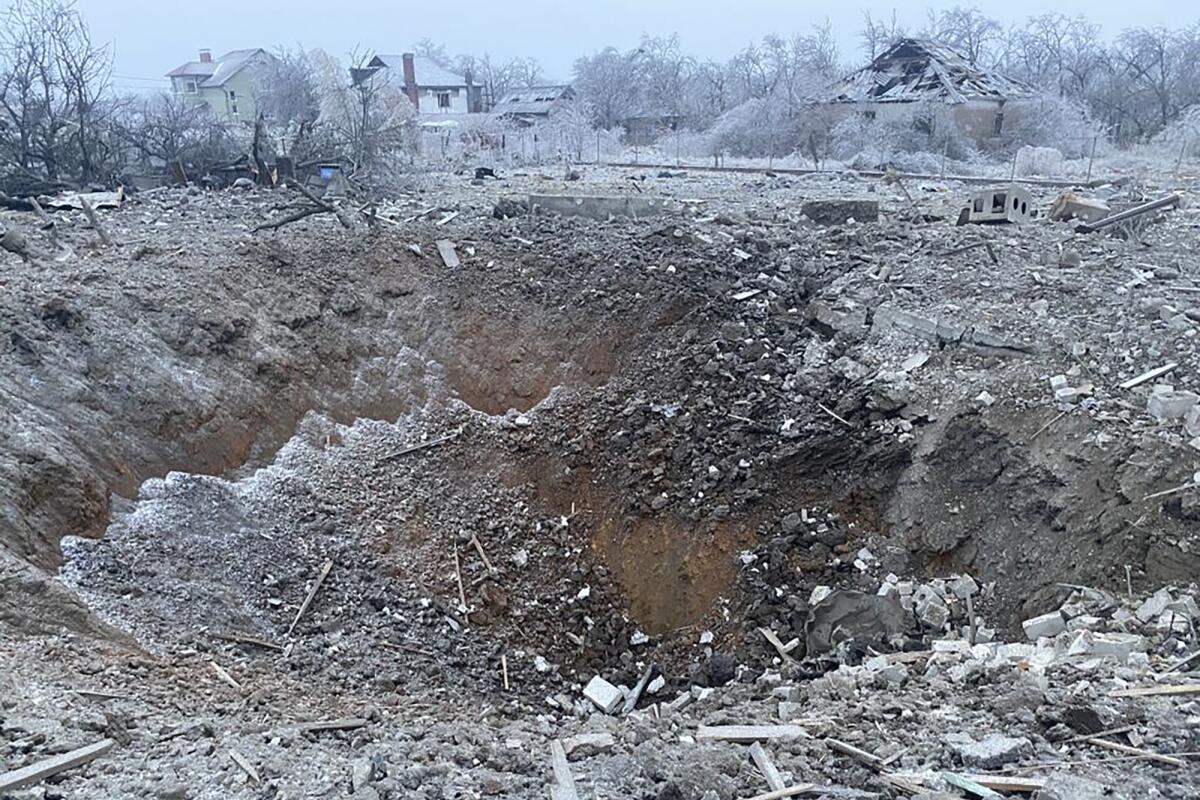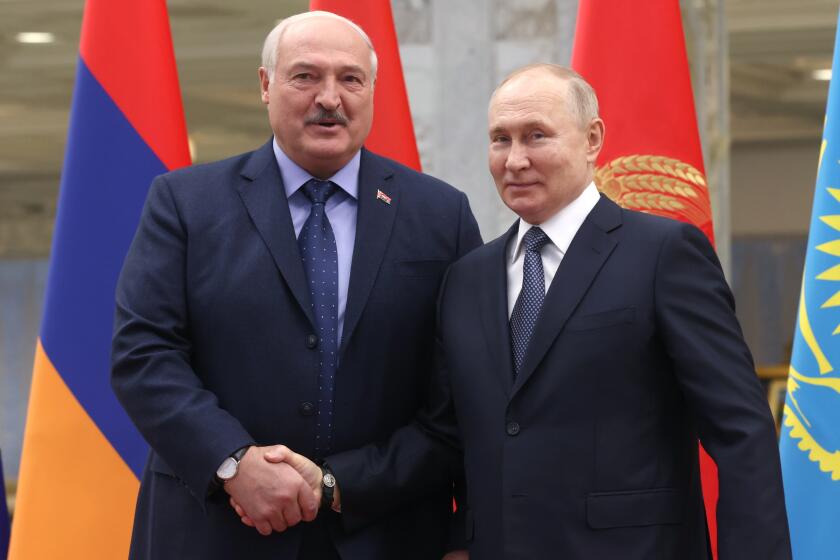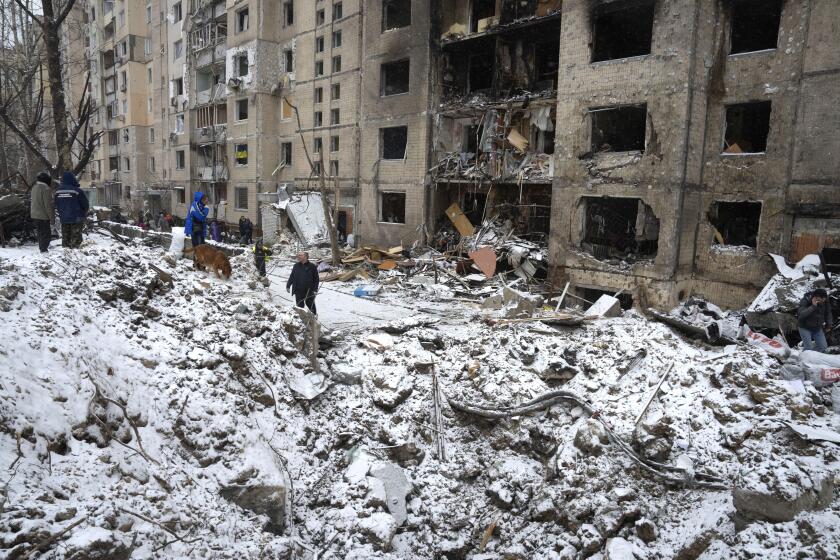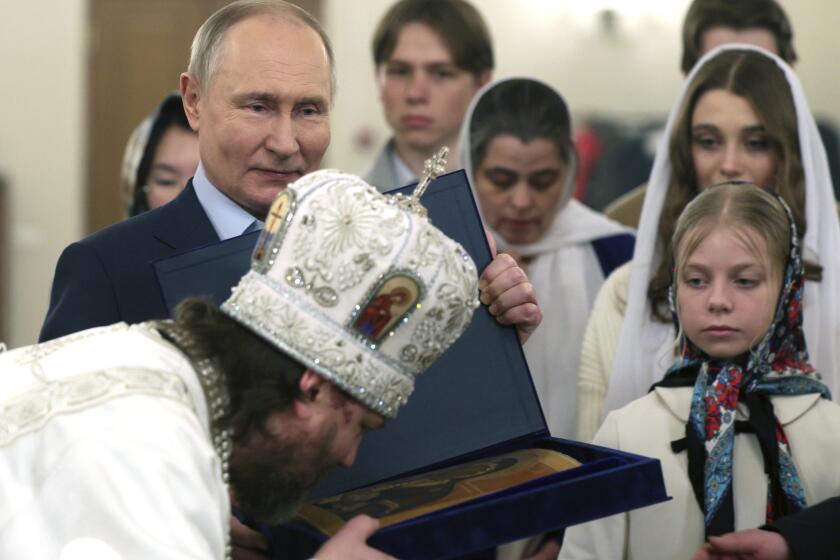Intensified Russian airstrikes are stretching Ukraine’s aerial defense resources

- Share via
KYIV, Ukraine — Russia’s recent escalation of missile and drone attacks is stretching Ukraine’s air defense resources, a Ukrainian air force official said Tuesday, leaving the country vulnerable unless it can secure further weapons supplies as the war drags on.
“Intense Russian air attacks force us to use a corresponding amount of air defense means,” air force spokesman Yurii Ihnat told national television. “That’s why we need more of them, as Russia keeps increasing its [aerial] attack capabilities.”
As soldiers on both sides fight from largely static positions along the roughly 930-mile front line, recent Russian attacks have used large numbers of various types of missiles in an apparent effort to overwhelm air defense systems and find gaps in Ukraine’s defenses.
The massive barrages — more than 500 drones and missiles were fired between Dec. 29 and Jan. 2, according to officials in Kyiv — are also using up Ukraine’s weapons stockpiles.
Ukraine uses weapons from the Soviet era and more modern ones provided by its Western allies. Authorities want to build up the country’s own weapons manufacturing capabilities, and analysts say those plants are among Russia’s recent targets.
“At the moment, we are completely dependent on the supply of guided air defense missiles, for both Soviet and Western systems,” Ihnat said.
Russia and Ukraine have exchanged hundreds of prisoners of war under a deal sponsored by the United Arab Emirates
President Volodymyr Zelensky said Sunday that “we lack a very concrete and understandable thing — that is, air defense systems” — to protect civilian areas and troop positions.
“We lack [them] both on the battlefield and in our cities,” he said at a Swedish defense conference.
Speaking at a meeting with Moscow’s military brass, Russian Defense Minister Sergei Shoigu declared that Kyiv’s efforts to bolster its firepower “won’t change the situation on the line of contact and will only drag out the military conflict.”
“We retain the strategic initiative along the entire line of contact,” Shoigu said. “We will consistently continue to achieve the objectives of the special military operation” — the Kremlin’s language for its invasion of Ukraine.
Belarus’ leader attended a meeting with children from Russia-controlled areas of Ukraine, defying outrage over involvement in Moscow’s deportation of them.
It was not possible to verify either side’s battlefield claims.
Ukraine, meanwhile, has increasingly targeted Moscow-occupied Crimea and Russian border regions with long-range strikes.
In the latest strike, two drones fell on the premises of a fuel and energy facility Tuesday in the Russian city of Orlov, about 150 miles from the Ukrainian border, Gov. Andrei Klychkov said.
Three people were injured and a fire broke out but was quickly extinguished, Klychkov said.
Nepal’s government has banned its citizens from going to Russia and Ukraine for work, saying many have been recruited by the Russian army to fight.
The British Defense Ministry pointed to repeated signs of shortcomings in Russia’s air defenses. Ukrainian strikes on military targets in Crimea on Thursday demonstrated “the ineffectiveness of Russian air defenses in protecting key locations,” the ministry said Tuesday.
The Kremlin’s forces show no signs of easing off their winter campaign. In what officials called the biggest aerial barrage of the war, Russia launched 122 missiles and dozens of drones Dec. 29, killing 62 civilians across the country. On New Year’s Day, Russia launched a record 90 Shahed-type drones across Ukraine.
Russia has expanded its own production of missiles and drones, analysts say, and has begun using short-range missiles provided by North Korea.
Ukrainian officials have pleaded with the West for more weapons, especially air defense and artillery shells.
Russian military personnel marked Orthodox Christmas on Sunday, nearly two years after Russia launched its unprovoked invasion of Ukraine.
However, a plan by the Biden administration to send to Kyiv billions of dollars in further aid is stuck in Congress, and Europe’s pledge in March to provide1 million artillery shells within 12 months has come up short, with only about 300,000 delivered so far.
U.S.-made surface-to-air Patriot missiles give Ukraine an effective shield against Russian airstrikes, but the cost is up to $4 million per missile, and the launchers cost about $10 million each, analysts say.
Such costly support is “essential” for Ukraine, a U.S. think tank said.
“The continued and increased Western provision of air defense systems and missiles to Ukraine is crucial as Russian forces continue to experiment with new ways to penetrate Ukrainian air defenses,” the Washington-based Institute for the Study of War said.
More to Read
Sign up for Essential California
The most important California stories and recommendations in your inbox every morning.
You may occasionally receive promotional content from the Los Angeles Times.














